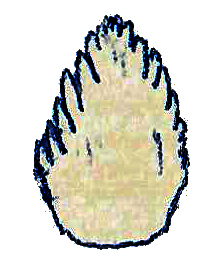History
Phyllodon is based on MGSP G5, a partial lower jaw tooth recovered from a lignite marl in a mine near the city of Leiria. Richard Thulborn, who described the genus, added an upper beak tooth (MGSP G2). He regarded the new genus as a hypsilophodontid, and presented a conjectural restoration of the tooth arrangement. [2] Peter Galton, reviewing Late Jurassic North American hypsilophodontids a few years later, found that the Phyllodon teeth best matched those of Nanosaurus , and agreed with a hypsilophodontid identity because the lower jaw tooth is asymmetric in front and back views. [3]
Sometime before 2004, possible Phyllodon remains were recovered from the Chipping Norton Limestone of England. [1] It is likely that these remains actually belonged to an indeterminate ornithischian separate from Phyllodon. [4]
Because of the sparse material, Phyllodon has often been tossed off as a dubious basal ornithopod of uncertain affinities. [5] [6] However, more material that might belong to this genus has been recovered from the original locality and described. Included in this material are over 120 more teeth from all parts of the jaw and four partial lower jaws with the teeth lost. Oliver Rauhut, who described the new material, tentatively identified the lower jaws as Phyllodon due to there being no other similar dinosaurs found at the locality. The teeth were very small (up to 3 millimeters across, or 0.1 inches) and possibly juvenile. He also found additional diagnostic characteristics for Phyllodon in the new material, including very tall upper jaw teeth, indicating that it could be a valid genus after all. After comparing it to other hypsilophodonts, he found that it best matched the roughly contemporaneous Drinker of the North American Morrison Formation, with various details suggesting that they were closely related. [7] Similarly, Galton found its teeth to be similar to those of Drinker and Nanosaurus in his 2006 review. [8]
This page is based on this
Wikipedia article Text is available under the
CC BY-SA 4.0 license; additional terms may apply.
Images, videos and audio are available under their respective licenses.
